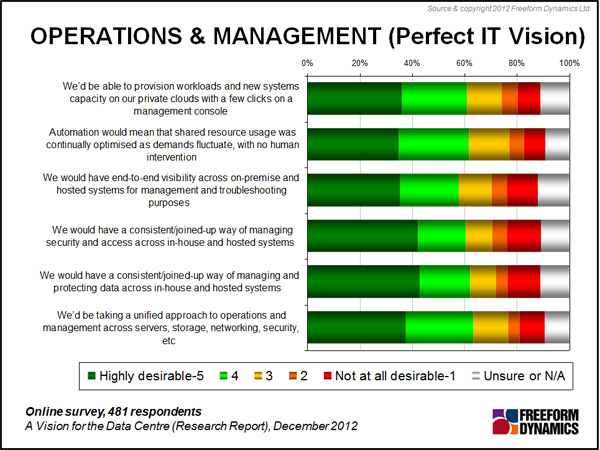By Tony Lock
Data centres and computer rooms are an important hub of many organisations, directly supporting many important business processes. As business needs evolve and technology advances most organisations add to their IT capabilities incrementally. These additions are usually made in response to specific business requirements and are often funded in isolation. This approach frequently leads to datacentres running systems that are only loosely interconnected and that are managed through the use of a wide range of disjointed tools.
Freeform Dynamics recently asked IT professionals for their vision of how they expect things in the data centre and computer room to change in the coming years and how their organisations will move forwards. (See here and here). It is clear from the results that there is huge potential for channel partners to help organisations move forwards. Even more to the point, there is clear indications that many organisations envisage major change in the next few years.

Figure 1
The survey posed the question of how desirable are certain capabilities in the operations and management space. Perhaps unsurprisingly it is clear that functionality with the potential to automate routine processes is well regarded. From the perspective of the channel it is especially interesting to note that almost two out of three respondents desire capabilities to reduce the time and effort required to deploy new services. These facilities are finally beginning to mature in management tools associated with integrated systems and the administration of virtualised systems.
It is also worth noting the high proportion indicating unifying management across servers, storage and networking to be very attractive. This result is very much in accord with other research we have carried out over the years showing organisations with integrated management tools operate more smoothly. Of equal importance such organisations also appear to be better at satisfying the needs of their businesses and find it less stressful in budget negotiations. The challenge for the channel is getting those who have not made the connection to invest in the tools, a task which can be difficult, but worthwhile for all parties.
The provision of integrated management tools is clearly another area of potential focus where there is a recognised vision but the challenge for organisations is how to move forwards. This is especially the case as few IT departments are well versed in making a coherent business case for such solutions. That said, there is evidence from this and other research showing more progressive organisations obtain value and benefits via the integration of management and teams, but not everyone realises this.
But such changes, and indeed the use of new integrated management tools, frequently necessitates not simply a change in technology. It usually also requires significant modification to work processes and the skill sets of the IT staff who will use them. These offer more potential for engagement, especially those with ‘best practice’ experience to pass on.
The desirability of such capabilities is one thing, but when do IT professionals expect them to become available? If we had asked such a question a couple of years ago, a majority of people working in the IT industry, including many vendors, would have considered them to be ‘pie in the sky’ idealisations. Today things have changed quite dramatically. (Figure 2)

Figure 2
As can be seen, there is a clear indication that significant numbers think capabilities to simplify management and automate workload deployment will be available within a decade. Beyond that, many even believe they will be here within three to five years, if they are not already available or likely to turn up in the next year or two. Once again, the challenge here will be to work with customers to make the case, as history shows that without a driving force things will not progress smoothly.
It must be recognised that web surveys such as this are likely to disproportionally attract those actively engaged in the area under investigation or people with a special interest in it. Even so, it is clear that many IT professionals expect that systems providing such capabilities will be with us in the foreseeable future, if not in the next budget cycle or two. The acceptance process automation could open the way for delivering managed services in areas that previously would have been labour intensive and requiring access to skills spread across a raft of management tools.
As the adoption of systems suited to the automated delivery of IT services gains ground it is likely that mid-sized enterprises and larger will seek advice on how they can exploit new offerings. There is little doubt that anyone able to demonstrate good practice will find people willing to listen, but effort will be required to get them the understand the case for investment.
Other factors may inhibit the rapid adoption of new systems, especially those designed to run multiple workloads. Some of these may concern how IT is funded. Traditionally departments acquired systems in order to run an application and such systems are still frequently funded by a single group or department. Today few organisations have IT budget models that are able to cater for building and operating a shared infrastructure used by much, if not all, of the business. It may be necessary to come up with new ways to sell such solutions, particularly in partnership with the major IT vendors, as well as facing the challenge of explaining potentially complex IT financing packages to time challenged customers.
The data centre of the future and the computer room of tomorrow are getting closer. Are you ready to help your customers exploit them?
CLICK HERE TO VIEW ORIGINAL PUBLISHED ON

Rehistration required